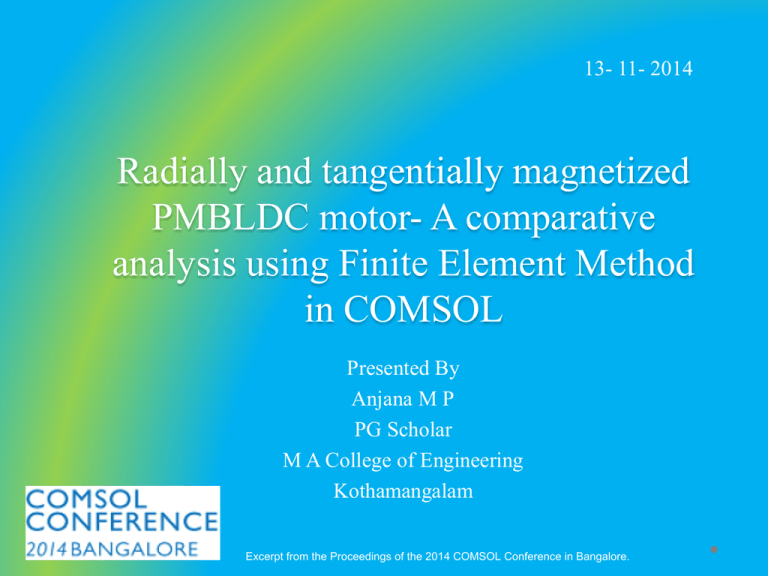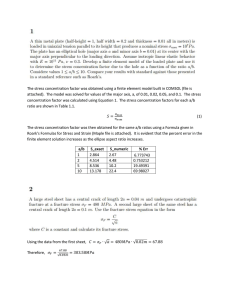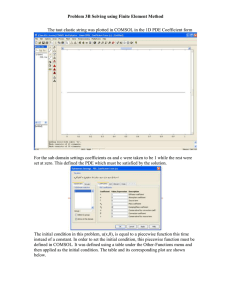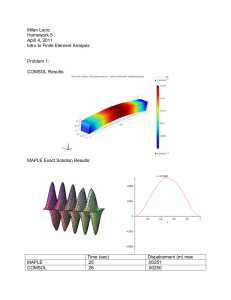Comparative analysis of Surface mounted and tangentially
advertisement

13- 11- 2014 Radially and tangentially magnetized PMBLDC motor- A comparative analysis using Finite Element Method in COMSOL Presented By Anjana M P PG Scholar M A College of Engineering Kothamangalam Excerpt from the Proceedings of the 2014 COMSOL Conference in Bangalore. Radially and tangentially magnetized PMBLDC motor- A comparative analysis using Finite Element Method in COMSOL Presentation Outline • Introduction • Objective • Literature Survey • Modeling Using Finite Element Analysis • Surface Mounted PM Motors (SMPM) • Tangentially Magnetized PM Motors • Comparison & Results • Conclusion • References Excerpt from the Proceedings of the 2014 COMSOL Conference in Bangalore. 2 Radially and tangentially magnetized PMBLDC motor- A comparative analysis using Finite Element Method in COMSOL Introduction • BLDC Motor does not use brushes for its operation. • Electronic commutation using switches. • Better thermal capability. • Design is focusing on servo application. • Different rotor configurations are possible according to applications. Surface Mounted PM motor Interior permanent magnet motor • Finite element analysis (FEA) using COMSOL Multiphysics. Excerpt from the Proceedings of the 2014 COMSOL Conference in Bangalore. 3 Radially and tangentially magnetized PMBLDC motor- A comparative analysis using Finite Element Method in COMSOL Objective • Familiarize the permanent magnet BLDC motor. • Design PM BLDC motor with two different rotor configuration. • Comparison of Surface mounted PM motor and tangentially magnetized PM motor. Excerpt from the Proceedings of the 2014 COMSOL Conference in Bangalore. 4 Radially and tangentially magnetized PMBLDC motor- A comparative analysis using Finite Element Method in COMSOL Literature review Permanent magnet Brushless dc motor: ( By T. J. E. Miller) • • • • • • • Electric winding on the stator and PMs on the rotor. High efficiency Higher speed ranges Better speed versus torque characteristics Long operating life Noiseless operation Higher dynamic response Fig. PMBLDC Motor Excerpt from the Proceedings of the 2014 COMSOL Conference in Bangalore. 5 Radially and tangentially magnetized PMBLDC motor- A comparative analysis using Finite Element Method in COMSOL Literature review Permanent magnet BLDC rotor configurations: Surface mounted PM Inset PM With external rotor Interior PM rotor V shaped buried PM Tangentially magnetized PM 1. 2. 3. 4. Surface mounted PM Inset PM SMPM with outer rotor V shaped buried PM 5. Tangentially magnetized PM Excerpt from the Proceedings of the 2014 COMSOL Conference in Bangalore. 6 Radially and tangentially magnetized PMBLDC motor- A comparative analysis using Finite Element Method in COMSOL Finite Element Analysis • The finite element modeling includes the Maxwell’s equation • Better understanding of the response/behavior of an electromagnetic device • Virtual prototyping ,saving time and cost Stator Air gap Rotor Excerpt from the Proceedings of the 2014 COMSOL Conference in Bangalore. 7 Radially and tangentially magnetized PMBLDC motor- A comparative analysis using Finite Element Method in COMSOL Motor Specifications Parameters Specifications Supply Voltage 28V Magnetic flux density, B Back EMF constant, Kb Torque Constant, Kt Outer Diameter Stack length, L Rotor Dia. No. of turns, Nt Rated Current, i Rated Speed Rated torque, T Magnet 0.9 T 0.16 0.16 52mm 45mm 30mm 40 9.0 A 1700 rpm 1.45 Nm SmCo5 Excerpt from the Proceedings of the 2014 COMSOL Conference in Bangalore. 8 Radially and tangentially magnetized PMBLDC motor- A comparative analysis using Finite Element Method in COMSOL Modeling Using Finite Element Analysis Find the no. of turns: From Miller’s Torque Equation: 𝑻 = 𝑵𝒑𝒉 − 𝟏 𝑵𝒕 𝑲𝒘 𝜶 𝒓𝑳𝑩𝒈 𝒊 = 𝑲𝒕 . 𝒊 ………(1) where α = pole arc coefficient = N + 0.14 < 1, N is integer No. of slot per pole = 0.697 𝑲𝒘 = Winding factor (= 0.89) Hence, No. of turns, 𝑵𝒕 = 40 per slot Excerpt from the Proceedings of the 2014 COMSOL Conference in Bangalore. 9 Radially and tangentially magnetized PMBLDC motor- A comparative analysis using Finite Element Method in COMSOL Modeling Using Finite Element Analysis • Slot/pole = 36/8 = 4.5 ( take 4) • Electrical angle = (360*4)/36= 40° • Quadrant Operation Winding Diagram: Phases 1 2 Electric angle 40° A N 80° 120° 4 5 6 7 8 160° 200° 240° 280° 320° S B C 3 N S 9 360° N N S N N Excerpt from the Proceedings of the 2014 COMSOL Conference in Bangalore. 10 Radially and tangentially magnetized PMBLDC motor- A comparative analysis using Finite Element Method in COMSOL Surface Mounted PM Motors (SMPM) • Permanent magnets mounted on the surface of the soft iron material. • Produce radially directed flux. • The width of magnet taken to be 8mm. • Height as 2.5 mm. Permanent Magnet Shaft Rotor Core Excerpt from the Proceedings of the 2014 COMSOL Conference in Bangalore. 11 Radially and tangentially magnetized PMBLDC motor- A comparative analysis using Finite Element Method in COMSOL Surface Mounted PM Motors (SMPM) Magnet arrangement Contour plot Excerpt from the Proceedings of the 2014 COMSOL Conference in Bangalore. 12 Radially and tangentially magnetized PMBLDC motor- A comparative analysis using Finite Element Method in COMSOL Surface Mounted PM Motors (SMPM) Excerpt from the Proceedings of the 2014 COMSOL Conference in Bangalore. 13 Radially and tangentially magnetized PMBLDC motor- A comparative analysis using Finite Element Method in COMSOL Tangentially Magnetized PM Motors • Each permanent magnet is embedded inside the rotor. • The magnetic flux density is taken to be at the circumference of the rotor. • The magnet width of 2.5 mm and depth of 8 mm is taken. Excerpt from the Proceedings of the 2014 COMSOL Conference in Bangalore. 14 Radially and tangentially magnetized PMBLDC motor- A comparative analysis using Finite Element Method in COMSOL Tangentially Magnetized PM Motors Magnet arrangement Contour plot Excerpt from the Proceedings of the 2014 COMSOL Conference in Bangalore. 15 Radially and tangentially magnetized PMBLDC motor- A comparative analysis using Finite Element Method in COMSOL Tangentially Magnetized PM Motors Excerpt from the Proceedings of the 2014 COMSOL Conference in Bangalore. 16 Radially and tangentially magnetized PMBLDC motor- A comparative analysis using Finite Element Method in COMSOL Vector diagram of magnetic flux density Surface Mounted PM Motors (SMPM): 𝑐𝑜𝑠 𝜃 = 𝑠𝑖𝑛 𝜃 = 𝐵∗𝑥 𝑥 2 +𝑦 2 𝐵∗𝑦 𝑥 2 +𝑦 2 Tangentially Magnetized PM Motors: 𝑐𝑜𝑠 𝜃 = 𝑠𝑖𝑛 𝜃 = 𝐵∗𝑦 𝑥 2 +𝑦 2 Vector diagram − 𝐵∗𝑥 𝑥 2 +𝑦 2 Excerpt from the Proceedings of the 2014 COMSOL Conference in Bangalore. 17 Radially and tangentially magnetized PMBLDC motor- A comparative analysis using Finite Element Method in COMSOL Inductance Calculation Magnetic Energy method: 𝟏 𝟐 𝑾 = 𝑳𝑰 𝟐 Where W = Magnetic Energy density Virtual work method: Based on Ohm’s Law 𝑽(𝒊𝒏𝒅𝒖𝒄𝒆𝒅) 𝑳= 𝒊 ∗ 𝟐𝝅𝒇 V (induced) is not produced by magnetic field due to permanent magnet. Excerpt from the Proceedings of the 2014 COMSOL Conference in Bangalore. 18 Radially and tangentially magnetized PMBLDC motor- A comparative analysis using Finite Element Method in COMSOL Comparison based on inductance Difference in air gap inductance: With 2 phases excited With R phase excited Using Energy Method 11.4 mH 4.1mH Using Virtual work method 11.4 mH 4.1 mH Using Energy Method 14.5 mH 5.5mH Using Virtual work method 14.5 mH 5.5mH Motor type SMPM Tangentially Magnetized Excerpt from the Proceedings of the 2014 COMSOL Conference in Bangalore. 19 Radially and tangentially magnetized PMBLDC motor- A comparative analysis using Finite Element Method in COMSOL Waveforms Magnetic flux density variation at the air gap Bg plot for SMPM motors Bg plot for tangentially Magnetized PM Excerpt from the Proceedings of the 2014 COMSOL Conference in Bangalore. 20 Radially and tangentially magnetized PMBLDC motor- A comparative analysis using Finite Element Method in COMSOL Waveforms By Maxwell’s stress tensor method. . Torque, 𝑻 = 𝑩 𝒓 − 𝒓𝒐 × 𝒏𝟏 𝑻𝟐 𝒅𝑺 Where r0 is the point on the axis of rotation and n is unit vector normal to the surface S. Torque produced in SMPM motor Torque produced in tangentially magnetized PM Excerpt from the Proceedings of the 2014 COMSOL Conference in Bangalore. 21 Radially and tangentially magnetized PMBLDC motor- A comparative analysis using Finite Element Method in COMSOL Waveforms 𝟏 𝟐 Cogging Torque, 𝑻 = − Ф𝟐 Cogging torque variation for SMPM motor 𝒅𝑹 𝒅𝒕 Cogging torque profile for tangentially magnetized PM motor Excerpt from the Proceedings of the 2014 COMSOL Conference in Bangalore. 22 Radially and tangentially magnetized PMBLDC motor- A comparative analysis using Finite Element Method in COMSOL Waveforms Back EMF variation for both rotor configurations Induced Voltage, 𝑽 = 𝑵 𝑳 𝑨 𝑬𝒛 𝒅𝑨 Torque waveforms for estimating the ripple torque Excerpt from the Proceedings of the 2014 COMSOL Conference in Bangalore. 23 Radially and tangentially magnetized PMBLDC motor- A comparative analysis using Finite Element Method in COMSOL Conclusion A three phase 36 slot, 8 pole BLDC motor applied for aero space applications was used for analysis. Comparison was done for Surface mounted, radially magnetized motor and tangentially magnetized motor using COMSOL Multiphysics 3.5a. Main difference was found in air gap inductance . The interior permanent magnet design gave desirably more inductance than surface mounted PM design. Excerpt from the Proceedings of the 2014 COMSOL Conference in Bangalore. 24 Radially and tangentially magnetized PMBLDC motor- A comparative analysis using Finite Element Method in COMSOL References [1] J. R. Hendershot Jr., T.J.E. Miller. “ Design of Brushless Permanent magnet motors” . Magna Physics publishing and Clarendon press- Oxford 1994. [2] P. Ji, W. Song, and Y. Yang, “Overview on application of permanent magnet brushless DC motor,” Electrical Machinery Technology, vol.40, pp.32-36, Feb. 2003. [3 Shihua Wu, Likun Tian, Shumei Cui, “A Comparative Study of the Interior Permanent Magnet Electrical Machine’s Rotor Configurations for a Single Shaft Hybrid Electric Bus” IEEE Conf. on Vehicle Power and Propulsion, September 3-5, 2008. [4] Tayfun, Gundogdu, Guven Komurgoz, “Design of Permanent Magnet Machines with Different Rotor Type” World Academy of Science, Engineering and Technology Vol:4 2010-10-29. Excerpt from the Proceedings of the 2014 COMSOL Conference in Bangalore. 25 Radially and tangentially magnetized PMBLDC motor- A comparative analysis using Finite Element Method in COMSOL References [5] F.Libert,J. Soulard,“ Design study of different Direct-Driven Permanent-Magnet Motors for a low Speed Application”, Division of Electrical Machines and Power Electronics, Sewden, 2003. [6] Ping Zheng. Feng Chai, Yan Wang. Shukang Cheng, “Research on the magnetization of a tangentially magnetized brushless dc motor”, IEEE Magnetics Conference, pp. 1951 - 1952 ,Sept. 2005 [7] R.P. Praveen, M.H. Ravichandran, V.T. Sadasivan Achari, Dr. V.P. Jagathy, “ Optimal Design of a Surface Mounted Permanent-Magnet BLDC Motor for Spacecraft Applications” IEEE Conf. on Emerging Trends in Electrical and Computer Technology , 413-419 , 2011. [8] Why do infinite Element Analysis-NAFEMS [9] COMSOL3.5a manual Excerpt from the Proceedings of the 2014 COMSOL Conference in Bangalore. 26 Radially and tangentially magnetized PMBLDC motor- A comparative analysis using Finite Element Method in COMSOL THANK YOU Questions??? Excerpt from the Proceedings of the 2014 COMSOL Conference in Bangalore. 27 Radially and tangentially magnetized PMBLDC motor- A comparative analysis using Finite Element Method in COMSOL Winding Pattern Excerpt from the Proceedings of the 2014 COMSOL Conference in Bangalore. 28


